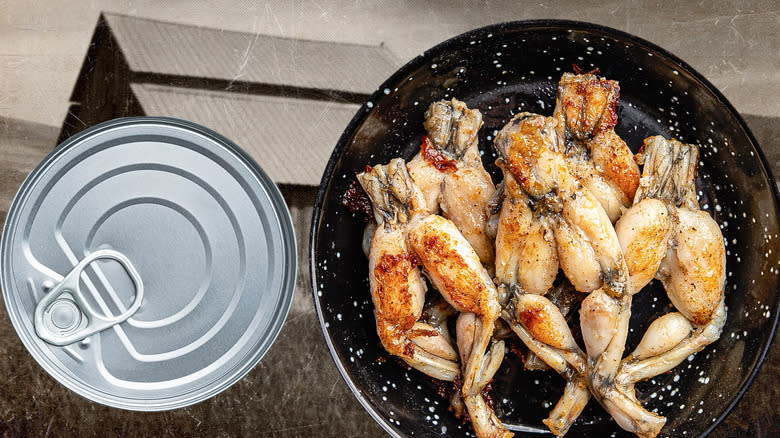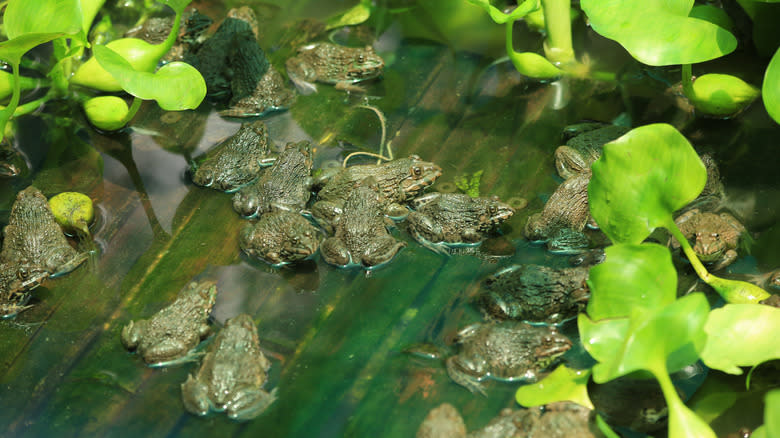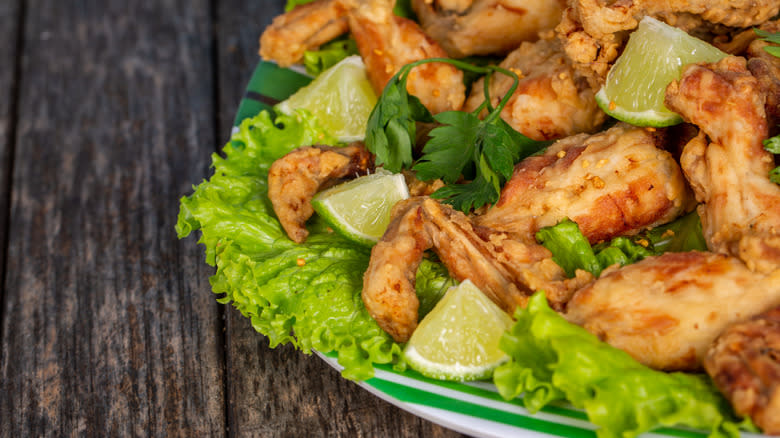Why The Bizarre 1930s Canned Frog Industry Crashed And Burned

With amphibians being the most vulnerable animals in the world facing possible extinction, organizations have been calling for frog legs to be removed from menus (or, at least, imposing restrictions on their consumption) to allow the global frog population to recuperate. The frog meat trade continues despite the crackdown, with canned frog meat sold online. The products available come almost exclusively from Thailand, which isn't surprising since frog meat is a farmed local delicacy. What's surprising is how frog-canning also seemed poised to be a viable industry in the U.S. nearly a century ago — until it crashed.
The trade's short-lived boom happened in the early '30s, in the wake of the Great Depression that had shuttered industries and left just over 25% of Americans unemployed. With basic commodities scarce, processed foods became popular as a cheaper way to assuage widespread hunger. Entrepreneur (and frog enthusiast) Albert Broel saw an opportunity for the business he'd established in 1933, the American Frog Canning Company. He began printing ads and instruction manuals that encouraged people to "raise giant frogs," which his company would buy for canning.
However, he didn't consider the difficulties of raising frogs, including on his farm in Louisiana. The slow trickle of farmed frogs coming in led him to rely on the catch sold by frog hunters. But with Louisiana passing a law in the late 1930s restricting frog hunting, Broel was forced to shut down his canning business.
Read more: What Happens If You Accidentally Eat Mold?
Farming Frogs For Canning Was Neither Practical Nor Profitable

Farming frogs is difficult because reaching maturity is a precarious process for these animals. Aside from having many creatures prey on them, there's also their cannibalistic behavior, with adult frogs typically eating their young and smaller frogs. Separating tadpoles and small frogs from the larger ones is a labor-intensive task. Frog farmers must also protect the animals from the various bacterial, viral, and fungal diseases they're vulnerable to.
Frogs also require live feed. In the wild, they prey on small insects, worms, snails, fish, and rodents. On a farm, however, farmers must raise and provide them with the live critters they like to eat; they can't be "trained" to consume anything other than their natural diet.
Frog farmers during the 1930s tried to raise American bullfrogs since these can weigh up to half a kilogram once full-grown. However, the Missouri Department of Conservation says bullfrogs need around 1.15 pounds of live food to reach a weight of 0.4 pounds. "with marketable legs." Each adult frog also requires around 20 feet of shoreline to hunt so farmers would need a sizable land, preferably with natural ponds, to raise them.
Broel's ads touted a payment between $1 and $5 for a dozen frogs, but far from the easy money they promised, frog farming turned out to be a bust. It also didn't offer quick returns as farmers would have to wait three years for bullfrogs to reach adulthood.
The Global Frog Meat Trade Poses A Threat To Survival

Frog farms still face the same hurdles, which is why the Missouri Department of Conservation advises that farming frogs is more feasible as a hobby than a business investment. Even with the research and attempts at innovation during the 1970s and 1980s, the cost of commercial production, specifically of American bullfrogs, along with these animal's natural behavior and biological requirements proved too high to overcome. The U.S. imports its frog meat (both from farmed and wild-caught frogs) from Mexico, Ecuador, China, Thailand, and Vietnam.
Canned frog meat was reported to have been well-received by Americans during the industry's brief stint; per a 1934 Tampa Daily Times story (via the Indiana State Library blog), " ... many folks think it is much more tasty and digestible [than chicken breast]." However, attempting to revive it today could still prove impractical, with the raw material requiring importation from overseas. Besides, frozen imported frog legs already sell well enough to restaurants that serve them.
Still, people should seriously consider avoiding ordering frog legs in bistros. Per the non-profit organization Pro Wildlife, species of wild, large frogs in Indonesia, Turkey, and Albania have been shrinking due to getting hunted for mass consumption. As tasty as their meat is, this species' refusal to be commodified may be a sign that they're best left as thriving members of the ecological system.
Read the original article on Tasting Table.

